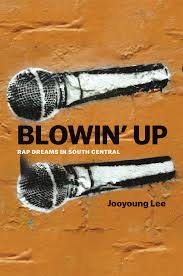Blowin’ Up: Rap Dreams in South Central
- By Jooyoung Lee
- University of Chicago Press
- 272 pp.
- Reviewed by E.A. Aymar
- March 7, 2016
This fascinating look at an oft-misunderstood musical genre suffers from the absence of women

A good friend once told me, "I'm not saying Eminem isn't talented, I just don't like him." I was surprised, but not by her dislike of the rapper — few entertainers have been as polarizing as Marshall Mathers. Rather, it was because she called him talented. I'd been listening to rap since the late eighties, and that was the first time I'd heard someone outside of the genre praise it.
Since then, rap has become both critically and commercially successful. That success has led to wider acknowledgment of the genre as an art form, political statement, and subject worthy of serious academic study. Jooyoung Lee's slim but detailed book, Blowin' Up: Rap Dreams in South Central, is an extension of that acceptance. In it, he studies the lives of several young men aspiring to become rappers as they train at Project Blowed, a legendary workshop and proving ground for rappers in Los Angeles.
Lee's affection for rap, and for the men he's profiling, is heartfelt and often moving (particularly when he chronicles the tragic life of the rapper Flawliss). Both longtime fans and newcomers to the music will find fascinating insights into the genre, and it's quickly apparent that the struggles of the aspiring musicians Lee writes about — the sacrifices, the high rate of failure, the use of daily employment only to support their dream — are germane to hopeful artists in any field.
The book’s mixture of biography and academic study is done to admirable effect, and Lee uses that approach to counter rap’s more common criticisms. For example, he takes pains to examine rap's rough posturing, particularly when it comes to “battling” — when rappers trade improvised rhymes in the hopes of humiliating each other.
Lee posits these battles as a healthy alternative to violence, given that it is understood by the participants that any violence is, at most, only implied. As he writes, “Rappers at Project Blowed can actually lose respect if they try to come across as thugs or gangstas on and off the microphone.”
This posturing is one of the most fascinating elements of Lee's study and something he returns to frequently, largely because violence constantly shadows the young men he studies. Becoming a rapper is a creative alternative to the criminality often presented to impoverished youths in urban environments. “Compared to the unattractive options in front of them — as gang bangers or in the low-wage labor market — rapping and pursuing their creative talents seemed like a better way to spend their time,” Lee writes.
The author’s analysis provides a wonderful response to those who claim that rap is a glorification of crime and violence, or even refuse to acknowledge it as music. What those critics fail to take into account, and what Lee explains so well, is that rap, like many emerging arts, is intentionally different than what came before it. Critics are often unwilling to accept the commercial displacement of more familiar (and safer) music, as well as the fact that rap is primarily a younger movement borne from, and frequently representative of, the experience of black youth in America.
That said, for all of Lee’s analysis, there is one glaring omission in the book: He provides no insight into female rappers. The author addresses this briefly in the opening chapter, when he writes: “Although there were a few regular ‘femcees’ when I did my fieldwork, the vast majority were young men. Also, I was immediately drawn to the freestyle and battle scenes, which were dominated by men…I have tried my best to offer a balanced perspective of this social world, but my perspective is necessarily partial. For the sake of a coherent and balanced narrative, I've decided to focus here on the people I know best — the young men at Project Blowed.”
Sure, but that absolutely, unforgivably leaves Lee’s work incomplete, especially since his study is so dependent on sociology and cultural theory. It's true that rap tends to be a male-dominated field, but the reasons for that domination need to be explored. Why weren’t female rappers present at Project Blowed? Is it because rap’s unfortunate but frequent misogyny turns away women, both as fans and artists? Is rap inherently geared toward the male experience?
These questions aren’t unnecessary or incidental; the answers would tie well to the struggles Lee so painstakingly details. It’s more than an omission; it’s a disservice to nonchalantly disregard the struggles and successes of “femcees” (a term that has come under attack as sexist). Particularly those underground female rappers who, like their male counterparts, place a value on intellectual lyrics and understand the traditions of the music (Jean Grae, Rapsody, Ruby Ibarra, Angel Haze, Theesatisfaction, and many, many others).
It’s distressing that women in rap are so casually disregarded in this work, and damning that they are frequently dismissed in hip hop. The inclusion might have turned Blowin’ Up from a good book into a great one. But despite that shortcoming, Lee’s study is an homage to, and necessary examination of, an often-misunderstood art form.
E.A. Aymar’s most recent novel is You're As Good As Dead. He’s a regular columnist with the Washington Independent Review of Books and managing editor of the Thrill Begins (for the International Thriller Writers). His short fiction and nonfiction have appeared in a number of top crime-fiction publications.

